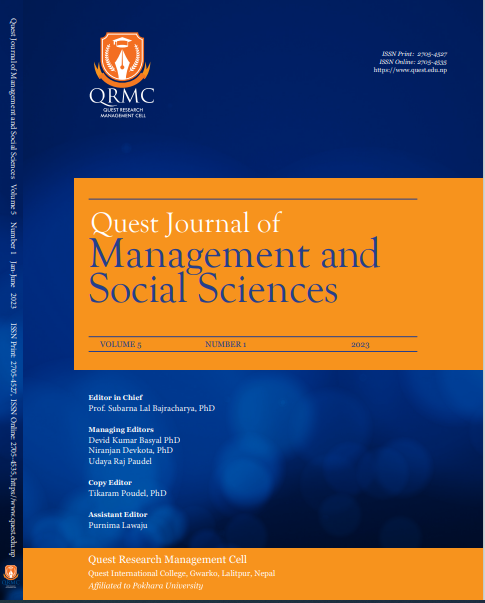Performance Evaluation of Technical Analysis in the Nepalese Stock Market: Implications for Investment Strategies
DOI:
https://doi.org/10.3126/qjmss.v5i1.56295Keywords:
Technical Analysis, Moving Average, Back testing, BootstrapAbstract
Purpose: This study aims to examine the performance of five widely used technical indicators on Nepal Stock Exchange (NEPSE) indexes. Specifically, the study evaluates indicators such as the simple moving average, moving average convergence and divergence, relative strength index, stochastic oscillator, and Bollinger Band.
Design/methodology/approach: The study utilizes a descriptive and quantitative research design. Daily closing index data of NEPSE and its six sub-indices are analyzed for a substantial period, ranging from 1st September 2012 to 31st August 2022. The performance of the technical indicators is examined through modeling, backtesting, and statistical analysis. The technical trading rules of each indicator are incorporated into the modeling process, and the results are analyzed using different performance metrics. Furthermore, the predictability of the indicators is tested through standard statistical analysis and bootstrap techniques utilizing a random walk model.
Findings: The results of the study reveal that the technical strategies, as represented by the analyzed indicators, generally support the effectiveness of technical analysis in the NEPSE. However, the relative strength index stands out as an exception, generating negative returns. The second stage of the analysis indicates that the simple moving average, relative strength, and Bollinger band fail to generate significant returns in certain indices. The findings from the bootstrap techniques further contradict the forecasting ability of technical strategies in the NEPSE, raising questions about their real performance in the Nepalese stock market.
Practical Implications: This research provides valuable insights for investors, traders, and market participants in understanding the nuances and limitations of technical analysis in the context of the NEPSE. The findings suggest that technical indicators, notably the relative strength index, should be interpreted cautiously and that investing decisions should take into account additional factors. The study contributes to the ongoing discussion on the effectiveness of technical analysis in the Nepalese stock market, assisting practitioners to make informed decisions and better understand market dynamics.
Downloads
Downloads
Published
How to Cite
Issue
Section
License
Copyright (c) 2023 Quest Journal of Management and Social Sciences

This work is licensed under a Creative Commons Attribution-NonCommercial-NoDerivatives 4.0 International License.
This license enables reusers to copy and distribute the material in any medium or format in unadapted form only, for noncommercial purposes only, and only so long as attribution is given to the creator.




